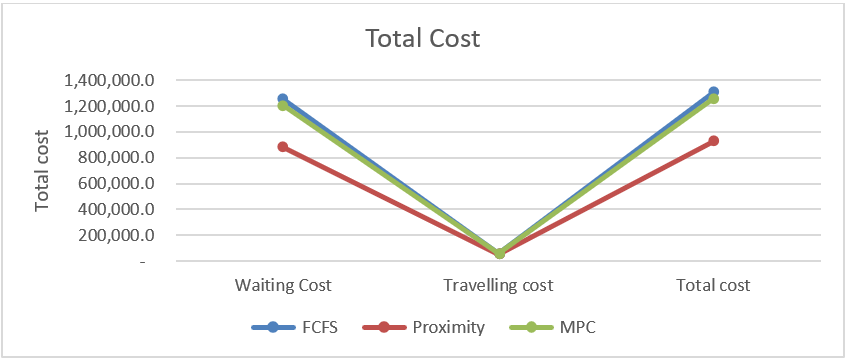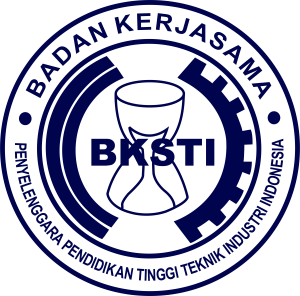Delivery service order policy with the sharing economy concept using a discrete event simulation system
DOI:
https://doi.org/10.12928/ijio.v4i2.7483Keywords:
Discrete event system, Minimize cost, Proximity algorithmAbstract
People's lifestyle, especially in shopping, has shifted from offline shopping, such as in supermarkets, traditional markets, stalls, and so on, to online shopping. Therefore, online business (e-commerce) has increased, resulting in a surge in the business potential of freight forwarder companies. When there is an increase in demand for the delivery of goods by sellers to consumers, companies need to make adjustments to improve their performance. This paper proposed the sequence of goods delivery services for XYZ companies by considering dynamic requests and conditions that vary discretely over time. This paper is based on a case company in Bandung, Indonesia. The method employed queuing models and discrete event simulations using hypothetical data with performance criteria to minimize the total cost of shipping goods. Simulations are carried out using one courier and one zone to compare customer service determination algorithms, namely first-come, first-served, proximity, and predictive control models. The simulation results show that the proximity algorithm produces a minimum total cost of Rp 1,785,749, the smallest cost compared to using first-come, first-served and predictive control models, respectively IDR 2,782,389, and IDR 2,639,291. Then, the Annova test was conducted, which provided information that one policy differed significantly from another, and a Turkey test was carried out, showing that the proximity algorithm produces better performance than other algorithms. The contribution of this paper is to present that the delivery service employed by the company provided a minimum total cost.
References
A. Adibfar, S. Gulhare, S. Srinivasan, and A. Costin, “Analysis and modeling of changes in online shopping behavior due to Covid-19 pandemic: A Florida case study,” Transp Policy (Oxf), vol. 126, pp. 162–176, Sep. 2022, doi: https://doi.org/10.1016/j.tranpol.2022.07.003
W. A. Lastri, and A. Anis, “Pengaruh E-Commerce, Inflasi dan Nilai Tukar Tukar Terhadap Pertumbuhan Ekonomi Indonesia.” Jurnal Kajian Ekonomi Dan Pembangunan 2, no. 2 (2020): 25-28, doi: http://dx.doi.org/10.24036/jkep.v2i2.12638
J. Liu, J. Chen, R. Bo, F. Meng, Y. Xu, and P. Li, “Increases or discounts: Price strategies based on customers’ patience times,” Eur J Oper Res, vol. 305, no. 2, pp. 722–737, Mar. 2023, doi: https://doi.org/10.1016/j.ejor.2022.06.015
Y. Giat, “Allocation of scarce resources in a network with periodic deliveries and customer tolerable wait,” Comput Ind Eng, vol. 159, Sep. 2021, doi: https://doi.org/10.1016/j.cie.2021.107462
D. K. Baroroh and C. H. Chu, “Human-centric production system simulation in mixed reality: An exemplary case of logistic facility design,” J Manuf Syst, vol. 65, pp. 146–157, Oct. 2022, doi: https://doi.org/10.1016/j.jmsy.2022.09.005
C. Liu and S. C. I. Chen, “A Novel Integrated Freight Forwarding Information System Based on Block-Chain Technology,” WSEAS Trans Inf Sci Appl, vol. 19, pp. 186–192, 2022, doi: https://doi.org/10.37394/23209.2022.19.19.
J. Azucena, B. Alkhaleel, H. Liao, and H. Nachtmann, “Hybrid simulation to support interdependence modeling of a multimodal transportation network,” Simul Model Pract Theory, vol. 107, Feb. 2021, doi: https://doi.org/10.1016/j.simpat.2020.102237.
P. Saraev, S. Blyumin, A. Galkin, and A. Sysoev, “Mathematical Remodeling Concept in Simulation of Complicated Variable Structure Transportation Systems,” in Transp Res Procedia, Elsevier B.V., pp. 475–482, 2020, doi: https://doi.org/10.1016/j.trpro.2020.03.041
U. Hwang and S. Guhathakurta, “Exploring the Impact of Bike Lanes on Transportation Mode Choice: A simulation-based, route-level impact analysis,” Sustain Cities Soc, vol. 89, Feb. 2023, doi: https://doi.org/10.1016/j.scs.2022.104318.
D. Wang and F. Liao, “Analysis of first-come-first-served mechanisms in one-way car-sharing services,” Transp Res Part B: Methodological, vol. 147, pp. 22–41, May 2021, doi: https://doi.org/10.1016/j.trb.2021.03.006.
G. Battumur, K. Gantumur, and W. Kim, “Factors affecting satisfaction with the postal delivery service,” Int J Adv Appl Sci, vol. 10, no. 1, pp. 111–120, Jan. 2023, doi: 10.21833/ijaas.2023.01.015.
O. Bueker, B. Kim, and J. Kim, “Customer equilibrium and optimal pricing in an M/G/1 queue with heterogeneous rewards and waiting cost rates,” Oper Res Lett, vol. 48, no. 2, pp. 152–156, Mar. 2020, doi: https://doi.org/10.1016/j.orl.2020.01.007.
L. R. de Abreu, B. de Athayde Prata, A. C. Gomes, S. A. Braga-Santos, and M. S. Nagano, “A novel BRKGA for the customer order scheduling with missing operations to minimize total tardiness,” Swarm Evol Comput, vol. 75, Dec. 2022, doi: https://doi.org/10.1016/j.swevo.2022.101149.
Q. Jiang, J. Penn, and W. Hu, “Real payment priming to reduce potential hypothetical bias,” J Choice Modell, vol. 45, Dec. 2022, doi: 10.1016/j.jocm.2022.100383.
N. Yiming and B. Z. Guo, “Asymptotic behavior of a retrial queueing system with server breakdowns,” J Math Anal Appl, vol. 520, no. 1, Apr. 2023, doi: https://doi.org/10.1016/j.jmaa.2022.126867.
Q. Sun, M. Dong, and A. Tan, “An order allocation methodology based on customer repurchase motivation drivers using blockchain technology,” Electron Commer Res Appl, vol. 56, Nov. 2022, doi: https://doi.org/10.1016/j.elerap.2022.101218.
K. Chargui, T. Zouadi, A. El Fallahi, M. Reghioui, and T. Aouam, “Berth and quay crane allocation and scheduling with worker performance variability and yard truck deployment in container terminals,” Transp Res E Logist Transp Rev, vol. 154, Oct. 2021, doi: https://doi.org/10.1016/j.tre.2021.102449.
B. de A. Prata, C. D. Rodrigues, and J. M. Framinan, “A differential evolution algorithm for the customer order scheduling problem with sequence-dependent setup times,” Expert Syst Appl, vol. 189, Mar. 2022, doi: https://doi.org/10.1016/j.eswa.2021.116097.
C. G. Cassandras and S. Lafortune, “Introduction to discrete event systems,” in Boston, MA: Springer US, 2008, doi: https://doi.org/10.1007/978-0-387-68612-7_11
J. Balun and T. Masopust, “On verification of D-detectability for discrete event systems,” Automatica, vol. 133, Nov. 2021, doi: https://doi.org/10.1016/j.automatica.2021.109884.
C. Peng and F. F. Chert, “Parallel Discrete Event Simulation of Manufacturing Systems: A Technology Survey,” Comput Ind Eng, vol. 31, 1996, doi: https://doi.org/10.1016/0360-8352(96)00142-8.
X. Han, K. Zhang, J. Zhang, Z. Li, and Z. Chen, “Strong current-state and initial-state opacity of discrete-event systems,” Automatica, vol. 148, Feb. 2023, doi: https://doi.org/10.1016/j.automatica.2022.110756.
D. Mourtzis, “Simulation in the design and operation of manufacturing systems: state of the art and new trends”, Int J Prod Res, vol. 58, no. 7, pp. 1927–1949, Apr. 2020, doi: https://doi.org/10.1080/00207543.2019.1636321
H. G. Daellenbach and D. C. Mcnickle, “Management science Decision making through systems thinking”. Bloomsbury Publishing, 2017. Available online: http://lms.aambc.edu.et:8080/xmlui/bitstream/handle/123456789/152/Management_science_Decision_making_throu.pdf?sequence=1
W. Adrianus, M. R. S. P. Edwin, and Y. Yanfi, “Furpare: Third-party application as furniture comparison in Indonesia’s e-commerce,” Procedia Comput Sci, vol. 216, pp. 77–85, 2023, doi: https://doi.org/10.1016/j.procs.2022.12.113.
J. Perez, M. P. de Looze, T. Bosch, and W. P. Neumann, “Discrete event simulation as an ergonomic tool to predict workload exposures during systems design,” Int J Ind Ergon, vol. 44, no. 2, pp. 298–306, Mar. 2014, doi: https://doi.org/10.1016/j.ergon.2013.04.007.
O. Bueker, B. Kim, and J. Kim, “Customer equilibrium and optimal pricing in an M/G/1 queue with heterogeneous rewards and waiting cost rates,” Oper Res Lett, vol. 48, no. 2, pp. 152–156, Mar. 2020, doi: https://doi.org/10.1016/j.orl.2020.01.007.
W. Hu, Y. Lu, and J. Ren, “A fixed-point proximity algorithm for recovering low-rank components from incomplete observation data with application to motion capture data refinement,” J Comput Appl Math, vol. 410, Aug. 2022, doi: https://doi.org/10.1016/j.cam.2022.114224.
Y. Liu, J. Komenda, T. Masopust, and Z. Li, “Modular control of discrete-event systems using similarity,” Automatica, vol. 142, Aug. 2022, doi: https://doi.org/10.1016/j.automatica.2022.110431.
R. E. Walpole, R. H. Myers, S.L. Myers, and K.Ye , “Probability and statistics for engineers and scientists,” New York: Macmillan, 1993.
N. Dvir, R. Hassin, and M. Haviv, “On equilibrium threshold strategies when choosing between observable and unobservable queues,” Oper Res Lett, vol. 50, no. 5, pp. 555–560, Sep. 2022, doi: https://doi.org/10.1016/j.orl.2022.08.004.
M. Liu, R. Liu, and X. Yang, “Workforce assignment in assembly line considering uncertain demand,” in IFAC-PapersOnLine, Elsevier B.V., Sep. 2019, pp. 223–228, doi: https://doi.org/10.1016/j.ifacol.2019.11.120.
Z. Jiang, L. Lei, J. Zhang, C. Wang, and S. Ye, “Spatio-temporal evolution and location factors of port and shipping service enterprises: A case study of the Yangtze River Delta,” J Transp Geogr, vol. 106, Jan. 2023, doi: https://doi.org/10.1016/j.jtrangeo.2022.103515.

Downloads
Published
How to Cite
Issue
Section
License
Copyright (c) 2023 Farida Nurmala Sihotang

This work is licensed under a Creative Commons Attribution-ShareAlike 4.0 International License.
License and Copyright Agreement
In submitting the manuscript to the journal, the authors certify that:
- They are authorized by their co-authors to enter into these arrangements.
- The work described has not been formally published before, except in the form of an abstract or as part of a published lecture, review, thesis, or overlay journal. Please also carefully read the International Journal of Industrial Optimization (IJIO) Author Guidelines at http://journal2.uad.ac.id/index.php/ijio/about/submissions#onlineSubmissions
- That it is not under consideration for publication elsewhere,
- That its publication has been approved by all the author(s) and by the responsible authorities tacitly or explicitly of the institutes where the work has been carried out.
- They secure the right to reproduce any material that has already been published or copyrighted elsewhere.
- They agree to the following license and copyright agreement.
Copyright
Authors who publish with the International Journal of Industrial Optimization (IJIO) agree to the following terms:
- Authors retain copyright and grant the journal right of first publication with the work simultaneously licensed under a Creative Commons Attribution License (CC BY-SA 4.0) that allows others to share the work with an acknowledgment of the work's authorship and initial publication in this journal.
- Authors are able to enter into separate, additional contractual arrangements for the non-exclusive distribution of the journal's published version of the work (e.g., post it to an institutional repository or publish it in a book), with an acknowledgment of its initial publication in this journal.
- Authors are permitted and encouraged to post their work online (e.g., in institutional repositories or on their website) prior to and during the submission process, as it can lead to productive exchanges, as well as earlier and greater citation of published work.

1.png)

